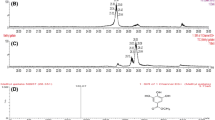Abstract
Brown sugar has been used traditionally for the treatment of skin trouble as a component of soaps or lotions. Symptoms of aging including wrinkles and pigmentation develop earlier in sun-exposed skin than unexposed skin, a phenomenon referred to as photoaging. Ultraviolet B (UVB) radiation is one of the most important environmental factors influencing photoaging. The aim of this study was to clarify whether the nonsugar fraction of brown sugar prevents chronic UVB-induced aging of the skin using melanin-possessing hairless mice. The nonsugar fraction (1% or 3% solution, 50 μl/mouse) was applied topically to the dorsal region every day for 19 weeks. Both solutions prevented an increase in skin thickness and reduction in skin elasticity caused by the UVB. The 3% solution also prevented wrinkles and melanin pigmentation as well as increases in the diameter and length of skin blood vessels. Increases in the expression of matrix metalloproteinase-2 (MMP-2) and vascular endothelial growth factor (VEGF) in UVB-irradiated skin was inhibited by the nonsugar fraction. Prevention of UVB-induced aging of the skin by topical application of the nonsugar fraction of brown sugar may be due to inhibition of increases in MMP-2 and VEGF expression.






Similar content being viewed by others
References
Kimura Y, Okuda H, Arichi S (1984) Effects of non-sugar fraction in black sugar on lipid and carbohydrate metabolism: Part I. Planta Med 50:465–468
Kimura Y, Okuda H, Shoji N, Takemoto T, Arichi S (1984) Effects of non-sugar fraction in black sugar on lipid and carbohydrate metabolism: Part II—New compounds inhibiting elevation of plasma insulin. Planta Med 50:469–473
Sams WM, Smith J (1961) The histochemistry of chronically sun damaged skin. J Invest Dermatol 37:447–452
Smith J, Davidson EA, Sams WM, Clark RD (1962) Alterations in human dermal connective tissue with age and chronic sun damage. J Invest Dermatol 39:347–350
Uitto J, Fazio MJ, Olsen DR (1989) Molecular mechanisms of cutaneous aging age-associated connective tissue alterations in the dermis. J Am Acad Dermatol 21:614–622
Bissett DL, Hannon DP, Orr TV (1987) An animal model of solar-aged skin: histological, physical, and visible changes in UV-irradiated hairless mouse skin. Photochem Photobiol 46:367–378
de Gruiji FR, Sterenborg HJ, Forbes PD, Davies RE, Cole C, Kelfkens G, van Weelden H, Slaper H, van der Leun JC (1993) Wavelength dependence of skin induction by ultraviolet irradiation of albino hairless mice. Cancer Res 53:53–60
Beissert S, Schwarz T (1999) Mechanisms involved in ultraviolet light-induced immunosuppression. J Investg Dermatol Symp Proc 4:61–64
Fisher GJ, Wang ZQ, Fatta SC, Varani J, Kang S, Voorhees JJ (1997) Pathophysiology of premature skin aging induced by ultraviolet light. N Engl Med 337:1419–1428
Inomata S, Matsunaga Y, Amano S, Takada K, Kobayashi K, Tsunenaga M, Nishiyama T, Kohno Y, Fukuda M (2003) Possible involvement of gelatinases in basement membrane damage and wrinkle formation in chronically ultraviolet B-exposed hairless mouse. J Invest Dermatol 120:128–134
Amano S, Akutsu N, Matsunaga Y, Kadoya K, Nishiyama T, Champliaud M-F, Burgeson RE, Adachi E (2001) Importance of balance between extracellular matrix synthesis and degradation in basement membrane formation. Exp Cell Res 271:249–262
Birkedal-Hansen H (1995) Protelytic remodeling of extracellular matrix. Curr Opin Cell Biol 7:728–735
Cox NH, Diffey BL, Farr PM (1992) The relationship between chronological age and the erythemal response to ultraviolet B radiation. Br J Dermatol 98:248–254
Kripke ML (1994) Ultraviolet radiation and immunology: something new under the sun-presidential address. Cancer Res 54:6102–6105
Pearse AD, Gaskell SA, Marks R (1987) Epidermal changes in human skin following irradiation with either UVB or UVA. J Invest Dermatol 88:83–87
Berton TR, Mitchell DL, Fischer SM, Locniskar MF (1997) Epidermal proliferation but not quantity of DNA photodamage is correlated with UV-induced mouse skin carcinogenesis. J Invest Dermatol 109:340–347
Kramer M, Sachsenmaier C, Herrlich P, Rahmsdorf HJ (1993) UV irradiation-induced interleukin-1 and basic fibroblast growth factor synthesis and release mediate part of the UV response. J Biol Chem 268:6734–6741
Strickland I, Rhodes LE, Flanagan BF, Friedmann PS (1997) TNF-α and IL-8 are upregulated in the epidermis of normal human skin after UVB exposure: correlation with neutrophil accumulation and E-selectin expression. J Invest Dermatol 108:763–768
Bielenberg DR, Bucana CD, Sanchez R, Donawho CK, Kripke ML, Fidler IJ (1998) Molecular regulation of UVB-induced cutaneous angiogenesis. J Invest Dertmatol 111:864–872
Yano K, Oura H, Detmar M (2002) Targeted over expression of the angiogenesis inhibitor thrombospondin-1 in the epidermis of transgenic mice prevents ultraviolet-B-induced angiogenesis and cutaneous photo-damage. J Invest Dermatol 118:800–805
Yano K, Kajiya K, Ishikawa M, Hong Y-K, Miyakawa T, Detmar M (2004) Ultraviolet B-induced skin angiogenesis is associated with switch in the balance of vascular endothelial growth factor and thrombospondin-1 expression. J Invest Dermatol 122:201–208
Bein K, Simons M (2000) Thrombospondin type 1 repeats interact with matrix metalloproteinase 2. Regulation of metalloproteinase activity. J Biol Chem 275:32167–32173
Taraboletti G, Sonzogni L, Vergani V, Hosseini G, Ceruti R, Ghilardi C, Bastone A, Toschi E, Borsotti P, Scanziani E, Giavazzi R, Pepper MS, Stetler-Stevenson WG, Bani MR (2000) Posttranscriptional stimulation of endothelial cell matrix metalloproteinases 2 and 1 by endothelioma cells. Exp Cell Res 258:384–394
Rodriguez-Manzaneque JC, Lane TF, Ortega MA, Hynes RO, Lawler J, Iruela-Arispe ML (2001) Thrombospondin-1 suppresses spontaneous tumor growth and inhibits activation of matrix metalloproteinase-9 and mobilization of vascular endothelial growth factor. Proc Natl Acad Sci USA 98:12485–12490
Acknowledgments
This work was supported in part by Grants-in-aid for Scientific Research (C) (No. 19590694; A representative: Maho Sumiyoshi, and No. 20590700; A representative: Yoshiyuki Kimura) from the Ministry of Education, Culture, Sports, Science and Technology, and the Orient Herb Co.
Author information
Authors and Affiliations
Corresponding author
Rights and permissions
About this article
Cite this article
Sumiyoshi, M., Hayashi, T. & Kimura, Y. Effects of the nonsugar fraction of brown sugar on chronic ultraviolet B irradiation-induced photoaging in melanin-possessing hairless mice. J Nat Med 63, 130–136 (2009). https://doi.org/10.1007/s11418-008-0301-9
Received:
Accepted:
Published:
Issue Date:
DOI: https://doi.org/10.1007/s11418-008-0301-9




